Related Research Articles

Oenothera is a genus of about 145 species of herbaceous flowering plants native to the Americas. It is the type genus of the family Onagraceae. Common names include evening primrose, suncups, and sundrops. They are not closely related to the true primroses.

Wiliwili, is a species of flowering tree in the pea family, Fabaceae, that is endemic to the Hawaiian Islands. It is the only species of Erythrina that naturally occurs there. It is typically found in Hawaiian tropical dry forests on leeward island slopes up to an elevation of 600 m (2,000 ft).

Hibiscus waimeae is a species of flowering plant within the okra family, Malvaceae, that is endemic to the island of Kauaʻi in Hawaii. It is a small gray-barked tree, reaching on average a height of 6–10 metres (20–33 ft) and an average trunk diameter of 0.3 m (0.98 ft). The flowers last for a single day, starting out white and fading to pink in the afternoon. H. arnottianus of Oʻahu and Molokaʻi and H. waimeae are the only Hawaiian hibiscuses that have white flowers. H. waimeae inhabits coastal mesic, mixed mesic, and wet forests at elevations of 250–1,200 m (820–3,940 ft).
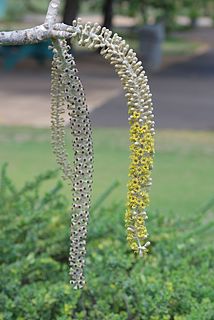
Polyscias racemosa, or false 'ohe, is a species of flowering plant in the family Araliaceae. As Munroidendron racemosum, the species was until recently considered to be the only species in the monotypic genus Munroidendron. With the change in classification, Munroidendron is now obsolete. Polyscias racemosa is endemic to the Hawaiian island of Kauai. It is very rare in the wild and some of its original habitat has been replaced by sugar cane plantations. It was thought for some time to be probably extinct, but was rediscovered a few years prior to 1967.
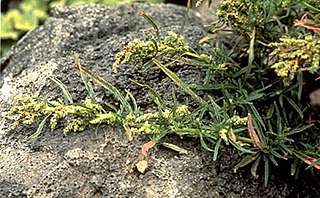
Amaranthus brownii was an annual herb in the family Amaranthaceae. The plant was found only on the small island of Nihoa in the Northwestern Hawaiian Islands, growing on rocky outcrops at altitudes of 120–215 m (394–705 ft). It was one of nine species of Amaranthus in the Hawaiian Islands, as well as the only endemic Hawaiian species of the genus. It is now considered extinct.

Cinnamomum burmannii, also known as Indonesian cinnamon, Padang cassia, Batavia cassia, or korintje, is one of several plants in the genus Cinnamomum whose bark is sold as the spice cinnamon. The most common and cheapest type of cinnamon in the US is made from powdered C. burmannii. C. burmannii oil contains no eugenol, but higher amounts of coumarin than C. cassia and Ceylon cinnamon with 2.1 g/kg in an authenticated sample, and a mean of 5.0 g/kg in 8 samples tested. It is also sold as quills of one layer.
Otto Degener was a botanist and conservationist who specialized in identifying plants of the Hawaiian Islands.
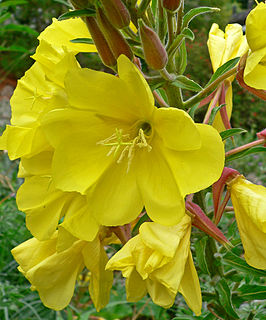
Oenothera elata is a species of Oenothera known by the common name Hooker's evening primrose or tall evening primrose. Subspecies include hookeri, hirsutissima, longisima, jamesii, villosa and elata. It is native to much of western and central North America. The plants are quite tall, especially the hookeri subspecies, native to California, which can reach about 1.8 meters height. The plants are found along roadsides, in moist meadows, or woodland, from sea level up to 9,000 ft (2,700 m) in elevation.

Robert F. Thorne was an American botanist. He was taxonomist and curator emeritus at Rancho Santa Ana Botanic Garden and professor emeritus at Claremont Graduate University in Claremont, California. His research has contributed to the understanding of the evolution of flowering plants.
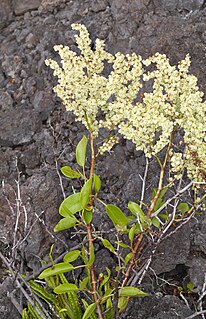
Rumex skottsbergii, or more commonly known as lava dock, is a shrub of the genus Rumex. The genus comprises approximately 200 species all derived from a single species and are therefore monophyletic. Furthermore, Rumex skottsbergii is endemic to Hawaii, where it is known as pawale. Pawale are commonly found in open lava fields that are at low elevations which range from 460-1300m. A similar plant in this genus is Rumex giganteus. Their similarity lies between their erect nature and leaves. However, the difference lies in their inflorescences. The inflorescences is described as being a cluster of flowers from the main stem axis.

Kadua is a genus of flowering plants in the family Rubiaceae. It comprises 29 species, all restricted to Polynesia. Twenty-two of these are endemic to the Hawaiian Islands. Some of the species are common at high elevation. Others are single-island endemics or very rare, and a few are probably extinct. Kadua affinis is widely distributed in Hawaii and is polymorphic. The type species for the genus is Kadua acuminata.

Oenothera macrocarpa, the bigfruit evening primrose, Ozark sundrop or Missouri evening primrose, is a species of flowering plant in the evening primrose family Onagraceae, native to Mexico and the south-central United States, where it is found in calcareous prairies and limestone outcrops.
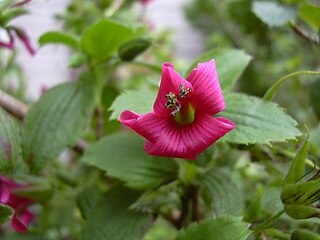
Geranium arboreum is a rare species of geranium known by the common names Hawaiian red-flowered geranium and Hawaii red cranesbill. It is endemic to Hawaii, where it is known only from the island of Maui. It was federally listed as an endangered species in 1992. Like other Hawaiian geraniums, this plant is known as hinahina and nohoanu.

Smilax melastomifolia, the Hawai'i greenbrier, is a species of spiny vine found in nature only in the Hawaiian Islands. Spines occur not only on the stems but also on the underside of the leaves and on the peduncles of female flowers. Berries are white or pale green.
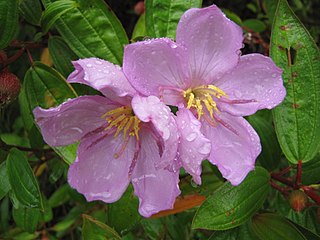
Melastoma septemnervium are erect shrubs or small slender trees with 5 petal, medium-sized, pink flowers that have made them attractive for cultivation. The leaves have the 5 distinctive longitudinal veins (nerves) typical of plants in the family Melastomataceae.
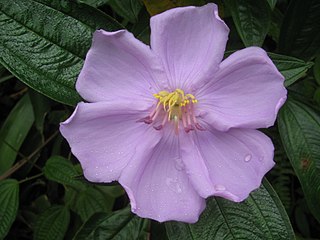
Melastoma sanguineum is called red melastome or fox-tongued melastoma in English. They are erect shrubs or small slender trees with medium-sized violet-pink colored flowers with 6 petals that have made them attractive for cultivation. The leaves have the 5 distinctive longitudinal veins (nerves) typical of plants in the family Melastomataceae.
Isa Irmgard Degener née Hansen was a German-American plant collector and botanist, specializing in agrostology. She is known as the coauthor of Flora Hawaiiensis.

Viola maviensis is a species of woody-stemmed violet endemic to Hawaii, United States.
Ann Kiku Sakai is a plant biologist at the University of California, Irvine known for her work on plant breeding and speciation. She is an elected fellow of the American Association for the Advancement of Science.
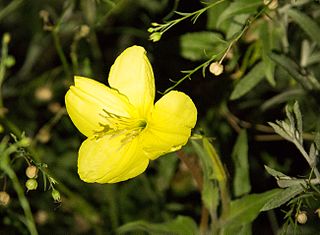
Oenothera organensis, the Organ Mountains evening-primrose, is a species of flowering plant in the family Onagraceae, native to a few valleys in the Organ Mountains of New Mexico. With only a few thousand individuals, it is nevertheless well-studied due to its complete self-incompatibility, which would seem to be maladaptive in such a rare species.
References
- 1 2 "Warren Wagner, Research Botanist and Curator of Botany". National Museum of Natural History, Smithsonian Institution. (with links to Wagner's articles and books)
- 1 2 Nathans, Aaron (November 9, 1994). "Science: Greenhouse Gives Botanists Fresh View of Plant Life : Smithsonian Institution's new $1-million botanical laboratory will allow scientists to study rare and endangered species". Los Angeles Times.
- 1 2 3 4 5 6 "Member: Treasurer. Wagner, Warren L." Washington Biologists' Field Club.
- ↑ Green, P. S. (1991). "Review of Manual of the Flowering Plants of Hawai'i by Warren L. Wagner, Derral R. Herbst, and S. H. Sohmer". Kew Bulletin. 46 (3): 595. doi:10.2307/4110564. ISSN 0075-5974. JSTOR 4110564.
- 1 2 "BSA Merit Award". Botanical Society of America (botany.org).
- ↑ "Engler Medal in Silver". IAPT.
- ↑ "Asa Gray Award". American Society of Plant Taxonomists.
- ↑ IPNI. W.L.Wagner.